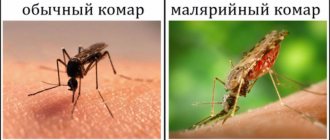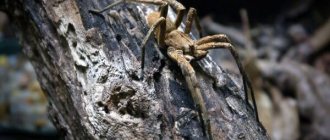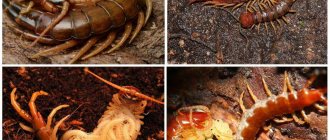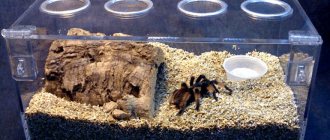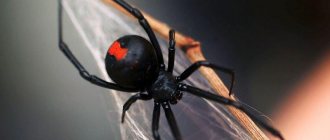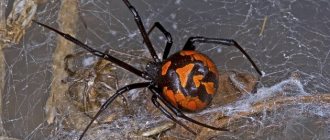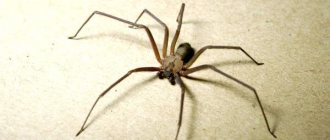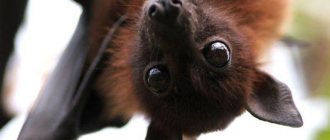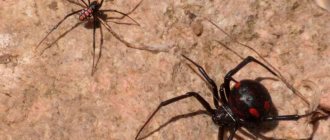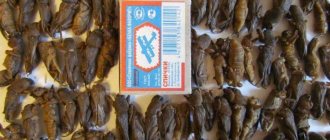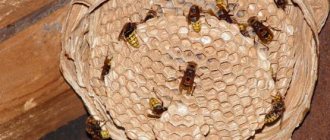Karakurt
One of the types of black widows. In the Volgograd region it is the most poisonous representative of eight-legged animals. Has characteristic spots all over its belly. Number of spots – 13.
Does not show aggression towards people and animals. But if you disturb him, he will bite instantly. Karakurt's bite acts instantly. A person experiences pain in the bite area, which after 15 minutes spreads throughout the body. Often, a person’s abdominal muscles become very tense and the area in the abdominal area hurts. Further, increased heart rate, vomiting, tremors, shortness of breath, sweating, etc. are observed. There are even cases of death after being bitten by people or cattle.
Araneomorpha spiders (Araneomorphae)
Funnel-web spiders (Agelenidae)
| Illustration | Name | a brief description of |
| Genus Agelena | ||
| Labyrinth spider ( Agelena labyrinthica ) | Distributed everywhere, reaching especially high numbers in anthropogenically transformed areas. | |
| Agelena taurica ( Agelena taurica ) | Single find. | |
| Genus Tegenaria | ||
| House spider ( Tegenaria domestica ) | Frequent inhabitant of cellars and basements of residential buildings. |
Web spiders (Theridiidae)
| Illustration | Name | a brief description of |
| Genus Episinus | ||
| Episinus truncatus | In floodplain and upland forests. | |
| Genus Euryopis | ||
| Euryopis flavomaculatus | In floodplain and upland forests. | |
| Genus Latrodectus | ||
| Karakurt ( Latrodectus tredecimguttatus ) | Karakurt is the most poisonous animal in the Volgograd region. As with many arthropods and insects, in the most favorable years due to climatic and other factors, there are population outbreaks. In the dry years of 2009 and 2010, there was an outbreak of this species, associated with favorable weather conditions; the northern border of the range of this species runs through the northern regions of the Samara region, more than 1000 km north of Volgograd. In the vicinity of Volgograd, this species has also taken a liking to spontaneous landfills, because here it is very easy to find a reliable shelter between the boards, and the nest, located in the folds of clothing, provides reliable shelter from bad weather and winter cold. | |
| Genus Robertus | ||
| Robertus neglectus | ||
| Genus Theridium | ||
| Theridium riparium |
Linyphiidae
| Illustration | Name | a brief description of |
| Genus Leptyphantes | ||
| Leptyphantes nebulosus | Widespread species. | |
| Pholcus opilinoides | Synanthropic species. |
Orb-weaving spiders (Araneidae)
| Illustration | Name | a brief description of |
| Genus Araneus - Crosses | ||
| Common crossweed ( Araneus diadematus ) | Settles on tall bushes and trees in forest ecosystems. May be found in populated areas. | |
| Angular crosswort ( Araneus angulatus ) | The length of the body can reach 2.5 cm. It settles on tall bushes and trees in forest ecosystems. The size of the fishing net reaches 90 cm. | |
| Araneus ceropegius | ||
| Araneus ullrichi | Settles on tall bushes and trees in forest ecosystems. | |
| Araneus cornutus or A. folium | Lives in semi-aquatic ecosystems. | |
| Araneus ixolobus | Doesn't always use a net for hunting. | |
| Genus Cyclosa | ||
| Cyclosa conica ( Cyclosa conica ) | ||
| Cyclosa sierrae | ||
| Genus Argiope | ||
| Argiope lobata ( Argiope lobata ) | Common type. Prefers steppe ecosystems. | |
| Argiope bruennichi _ _ | Common type. Prefers floodplain meadows. | |
| Genus Mangora | ||
| Mangora acalypha | Widespread species in the region. | |
| Genus Meta | ||
| Meta merianae | Single find. | |
| Genus Singa | ||
| Singa nitidula | Single find. |
Tetragnathidae
| Illustration | Name | a brief description of |
| Genus Tetragnatha | ||
| Tetragnatha montana | The only tenet species from this family in the region. |
Feather-legged spiders (Uloboridae)
| Illustration | Name | a brief description of |
| Genus Uloborus | ||
| Uloborus walckenaerius | The only species in the Volgograd region that builds horizontal or inclined wheel-shaped networks from cribellate web. |
Wolf spiders (Lycosidae)
| Illustration | Name | a brief description of |
| Genus Lycosa - Tarantulas | ||
| South Russian tarantula ( Lycosa singoriensis ) | The largest spider in the region's fauna. It is also found in the territory of Volgograd. |
Miturgidae
| Illustration | Name | a brief description of |
| Genus Cheiracanthium | ||
| Cheiracanthium erraticum [ no source specified 1551 days ] |
Gallery
For example, in the central and southern regions of the region you can find a representative of Theraphosidae with a velvety black color of the body itself and the hairs covering it, sometimes with orange spots on the ends of the legs; throughout the region there are quite a few spiders - jumping spiders with a very decorative color. Throughout the region, arthropods are common, including numerous species of Haymakers and Jumping Spiders, which are also widespread throughout the region. Even the mosquitoes living in the area arouse curiosity; sometimes they have bright colors, such as orange, red, green. In the region, such species as Sparassidae, Eusparassus, Atypus, Ummidia, Nemesiidae, and Cement spider are also interesting.
Common cross
A spider that probably everyone has seen. Females are larger than males. Their body length is 20-25 mm, while males are only 10 mm. Males have a narrow abdomen, females have a round abdomen. On the back there is a characteristic cross pattern, from which it gets its name. The entire abdomen of the spider is covered with a special coating that protects it from water evaporation.
Population and species status
Photo: Phalanx spider in Crimea
The desert lifestyle of the phalanx spider does not allow us to accurately determine the prevalence of populations of its species. Solifugae have become the subject of many myths and exaggerations about their size, speed, behavior, appetite and bite lethality. Members of this squad do not have poison and do not spin webs.
However, these spiders do not produce such an anesthetic, and like most creatures with a survival instinct, they do not attack prey larger than themselves except in a defensive situation or to protect offspring. Due to their bizarre appearance and the fact that they make a hissing sound when they feel threatened, many people are afraid of them. However, the biggest threat they pose to humans is their bite in self-defense.
The Phalanx spider leads a frantic lifestyle and is therefore not recommended as a pet. The nomadic lifestyle sometimes brings the spider phalanx into houses and other dwellings. There is no reason for alarm, so the arachnid can be placed in a container and taken outside. There have been no recorded deaths directly caused by the bite, but due to the strong muscles of their chelicerae, they can create a proportionally large, lacerated wound that can become infected. Only one species, Rhagodes nigrocinctus, has poison, but its bite is not harmful to humans.
Tags:
- Panarthropoda
- Omnivores
- Bilaterally symmetrical
- Animals of the Astrakhan region
- Animals of Africa
- Animals of Brazil
- Animals of the Volgograd region
- Animals of Greece
- Animals of Europe
- Animals of Transcaucasia
- Animals of Spain
- Animals of the Caucasus
- Animals of Kazakhstan
- Animals of Canada
- Animals of Kyrgyzstan
- Animals of Crimea
- Meadow animals
- Animals of the Volga region
- Animals of Portugal
- Desert Animals
- Animals of Russia
- Animals of the Saratov region
- Animals of North America
- Animals of the Subarctic Zone
- Animals of the Subtropical Zone of the Northern Hemisphere
- Animals of the Subtropical Zone of the Southern Hemisphere
- Animals USA
- Animals of Tajikistan
- Animals of the Temperate Zone of the Northern Hemisphere
- Animals of the Temperate Zone of the Southern Hemisphere
- Shedding
- Protostomes
- Carnivores
- Scorpios
- Solpugi
- Cheliceraceae
- Arthropods
- Eukaryotes
- Eumetazoans
- Poisonous spiders
Angular cross
A very rare species, which is listed in the Red Book in Russia.
It resembles an ordinary cross, but unlike the first one, it often lacks the characteristic cross pattern on its abdomen.
A characteristic feature of this species is the presence of two tubercles on the abdomen, from which it, in general, got its name.
It feeds, like many other species, using its web. Like any other spider, the angular cross cannot digest food on its own. Therefore, he releases his juice into the victim’s body, and after digesting it, he simply drinks the prepared nutrient solution.
Spider - description, characteristics and photographs
The body of arachnids consists of two parts:
- The cephalothorax is covered with a shell of chitin, with four pairs of long jointed legs. In addition to them, there is a pair of claws (pedipalps), used by mature individuals for mating, and a pair of short limbs with poisonous hooks - chelicerae. They are part of the oral apparatus. The number of eyes in spiders ranges from 2 to 8.
- Abdomen with breathing holes located on it and six arachnoid warts for weaving webs.
The size of spiders, depending on the species, ranges from 0.4 mm to 10 cm, and the span of their limbs can exceed 25 cm.
The coloring and pattern on individuals of different species depend on the structural structure of the integument of scales and hairs, as well as the presence and localization of various pigments. Therefore, spiders can have both dull, monochromatic and bright colors of various shades.
Argiope Brünnich
A very common type. The female is small in length, up to 15 mm. The male is 3 times smaller, rarely exceeding 5 mm. The legs are very long and thin. The spider's abdomen resembles the abdomen of a wasp.
Lives along roadsides or in meadows. Also, can be found in forest areas.
Like other types of spiders, it uses webs to catch prey. Weaves them in the dark. It takes about 60 minutes to create one network.
Hunter striped
In the Saratov region, 4 species of the family Pisauridae were discovered - hunting spiders belonging to 2 genera: Dolomedes and Pisaura. But only one of them is listed in the Red Book of the Saratov Region. This is a striped hunter.
Hunter striped
The name “plant” in this case is incorrect and is a copy of the Latin name of the species Dolomedes plantarius. Plantae is Latin for "plant".
Female striped hunters grow up to 2 cm. Males average 11 mm. In terms of description and appearance, the striped hunter is very similar to its “relative” – Dolomedes fimbriatus, whose name in Russian taxonomy is bordered. Both species live in the same area and are easily confused.
Striped and edged hunters differ in the width of the light stripe running along the entire body. The stripes begin from the cephalothorax and close at the end of the abdomen. The striped border on the cephalothorax is wider than on the abdomen.
Color brown. The abdomen is oval. The legs are thick, long, equipped with large spines.
Striped hunters live near water bodies. They also catch prey there, lying in wait for it at the water's edge. Females become sexually mature at 2 years. They breed twice a year. At one time, the female lays 500-600 eggs.
Black fathead
Shows activity in the dark. Hunts beetles that hide in cracks, holes and voids under stones. It preferentially hunts insects, but young lizards are often included in its diet.
In captivity, the Black Fathead can tolerate a long period of fasting: the male - up to 150 days, the female - up to 185 days.
This is a poisonous species, but its bites are not fatal. After the Black Fathead bites a person, he will feel a sharp pain at the site of the bite. It will subsequently lead to numbness and stiffness. The effect of the poison lasts up to 7 days.
Poisonous spiders
Karakurt
The black spider has a shiny body; juvenile and adult males of the species have 13 spots on their back. Males have creamy white spots, while young females have red (sometimes yellow or orange) spots. All adult females are black. Karakurts rarely come indoors, preferring grassy areas and especially hot, dry areas such as coastal dunes. They build webs close to the ground, in abandoned rodent burrows and under rocks and logs. The male karakurt stops feeding before mating and consequently dies of hunger.
Cross spiders
There are many types of crosses, they differ:
- shape;
- size;
- color.
Typically the species is 2 to 3 cm in length (females) and 1.5 to 2 cm (males). Most species are reddish brown or gray with leaf-shaped patterns on thick, triangular-shaped abdomens, and also have two prominent humps at the front. Cross spiders sometimes have a white or brown dorsal stripe with a white edge.
Hyracantidae
The upper abdomen has a dark, spear-shaped mark that runs down the middle of the abdomen from the point where the thorax and abdomen meet to about the middle of the abdomen.
The color ranges from light beige to yellow, often with a hint of green. The tips of the paws are dark brown.
These are nocturnal hunters who search for prey rather than catch it in a net. Spiders come into contact with humans if they get between the skin and sheets, clothing or shoes. They will also bite if provoked by a person while working in the garden or habitat.
Chiracantida bites are painful and the venom damages the skin, causing:
- slow healing wounds;
- itching;
- edema.
These bites are not considered medically dangerous.
Black Widow
It is a shiny, round black spider with a red hourglass mark on its ventral side (belly). There is also a red or orange spot above the spinnerets. This is the typical appearance of a female.
Male black widows are much smaller than females, with elongated purple, gray or black bodies, white ventral stripes and red, yellow or orange spots. Juvenile females are rounder than males, but have similar coloring and markings.
Body size of black widows: females from 8 to 13 mm, males from 3 to 6 mm. The paws are proportional to the body.
Brazilian wandering spider
Recluse spider
South Russian tarantula
The largest representative of spiders in the Volgograd region. The difference between females and males is insignificant. Males reach up to 25 mm in length, while females reach about 30 mm.
They live in burrows that they dig themselves. The spider digs a hole and weaves a web around it. The depth of the hole is about 40 cm. The tarantula sits at the entrance and attacks the victim as soon as it passes near the hole. Also, it kills those insects that accidentally wander into the hole.
This is a poisonous species. But it cannot cause death in humans or large animals. Swelling and redness form at the site of the bite. The pain of a South Russian tarantula bite is comparable to that of a person being stung by a hornet.
general characteristics
The greatest species diversity of poisonous animals in the Volgograd region is observed among representatives of the order of spiders ( Araneae
), of which there are over 80 species in the region.
Wasp and bee stings pose a certain danger to allergy sufferers.
The list of poisonous beetles of the region includes representatives of the rove beetle families ( Staphylinidae
), blister beetles (
Meloidae
), ladybugs (
Coccinellidae
) and others.
In the Volgograd region you can find about 7 species of snakes, only two of which are poisonous - (the steppe viper and Nikolsky's viper). Water snakes and patterned snakes, which are harmless to humans, are often mistaken for steppe vipers, which are relatively rare in the Volgograd region.
Poisonous amphibians
region do not pose a danger to humans.
Description of the spider
Spiders have 8 legs. The body is divided into 2 parts, they are connected by a thin stalk. Most spiders have 8 eyes, some have 6. A few arachnids outside Europe have 4 or 2 eyes. Spiders' eyes do not have one location; it depends on the species. Some spiders have the same size eyes, others have different ones. Most spiders have poor vision. But some species have large front eyes with fairly good vision:
The easiest way to determine whether an arachnid is male or female is to look at the front tentacles. In females they are quite narrow; in spiders, the tips of the tentacles resemble boxing gloves. Males use them as pipettes to release sperm during mating.
Which spiders are endemic to Russia and Europe, the most common species
Reproduction
The mating period occurs in the last month of summer, and at this time the males go in search of females. Having met a female, the male must show her his intentions, otherwise he risks being eaten.
The “suitor” raises the front part of his body, puts out the first pair of legs and vibrates his abdomen. In this position, he slowly approaches the female. Ready for mating, she begins to repeat the movements of the male. Immediately after fertilization, the male quickly leaves and prepares for winter: he makes his burrow deeper and clogs the entrance with soil.
The fertilized female also goes into her burrow for the winter. With the arrival of spring, it appears on the surface and exposes its abdomen to the sun's rays.
On a note! Warmth promotes the rapid development of eggs in the abdomen. By the way, it is this ritual that often leads to dehydration of the female’s body and she can lose about 30% of her weight!
When the maturation of the eggs in the abdomen ends, the female weaves a silk cocoon from the web. She lays her eggs in it and carries it on her abdomen for some time. At the same time, the cocoon with future offspring is always in her field of vision and the female actively protects it in any situation. If she senses danger, she will immediately fiercely grab onto the cocoon with her chelicerae and will no longer be able to take it away.
As soon as the female feels that the spiderlings are starting to emerge from the eggs, she breaks the cocoon and helps the babies get out. Young individuals climb onto the mother's body, and for some time she carries them on herself.
Gradually, the stronger offspring leaves the mother’s body, settling throughout the area.
In its natural habitat, the South Russian tarantula lives for about two years, in captivity a little longer, which is due to the absence of winter suspended animation, which to a certain extent slows down its development.
Content
- 1 Araneomorph spiders ( Araneomorphae
) 1.1 Funnel spiders (
Agelenidae
) - 1.2 Web spiders ( Theridiidae
) - 1.3 Lineifiae ( Linyphiidae
) - 1.4 Orb-weaving spiders ( Araneidae
) - 1.5 Tetragnathidae
- 1.6 Feather-legged spiders ( Uloboridae
) - 1.7 Eresidae
- 1.8 Amurobiidae
- 1.9 Wolf spiders ( Lycosidae
)
